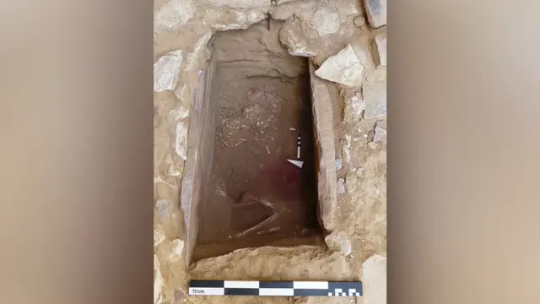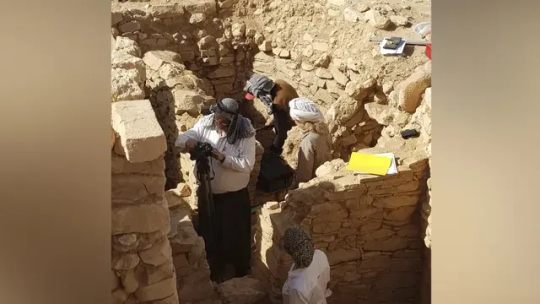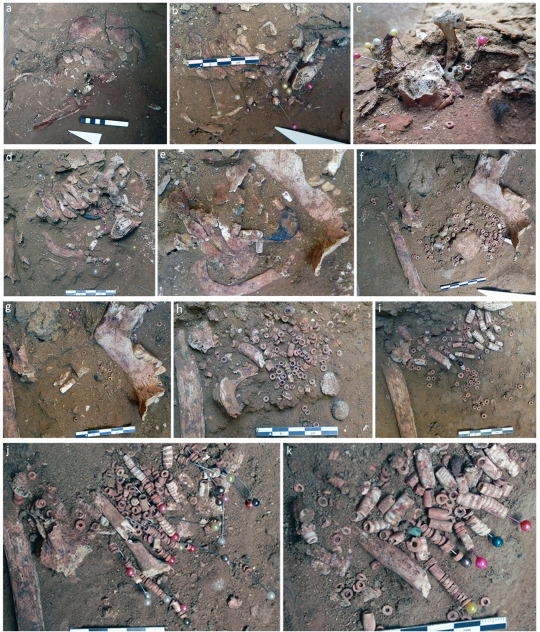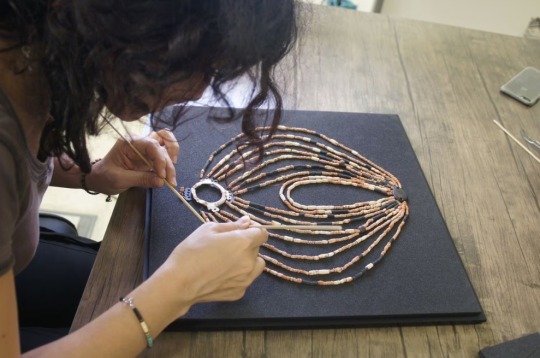#Extravagant Bead Necklace from Neolithic Child’s Grave Reassembled
Text

Extravagant Bead Necklace from Neolithic Child’s Grave Reassembled
An elaborate necklace of thousands of beads discovered in a child’s grave in the Neolithic village of Ba’ja, southern Jordan, has been reassembled bead by bead five years after it was unearthed. It is the most elaborate adornment ever found at a Neolithic site, and is a unique testament to the funerary practices of the elite in this prehistoric farming and livestock-raising community.
Located not far from the Nabatean rock-cut city of Petra, Ba’ja was occupied between around 7,400 and 6,800 B.C. It is densely packed with multi-layered stone dwellings that are believed to have been homes and stores for family units. While the deceased were usually buried elsewhere, some of the dead were buried in individual, double or collective graves underneath the structures.
In the summer of 2018, a stone-lined cist grave was found underneath the floor of a stone house. It contained the skeletal remains of a child about eight years old buried in fetal position. While the sex could not be conclusively determined, the shape of the chin suggests the child was female. The archaeological team named her Jamila (meaning “beautiful” in Arabic).
The skeleton was in a very poor state of preservation with bones missing and severely damaged by thousands of years and the heavy weight of the layers above the grave. Excavation revealed concentrations of beads of various materials and sizes mostly grouped around the child’s chest and neck. An astonishing 2,500 beads — flat beads, cylindrical beads, disc beads, tubular shell beads — were ultimately unearthed. Most of them were made of sandstone, but there were also turquoise, shell and amber beads from Lebanon that are the oldest ever discovered.


The bead concentrations were distributed between two large pendants: a mother-of-pearl ring carved from a large single pearl oyster shell with multiple perforations and a double-perforated oval hematite pendant. The mother-of-pearl is particularly spectacular, and cannot have been local. It was likely an import from the Red Sea more than 700 miles away.
Some of the beads were found still aligned in several rows on the left side (the child was positioned on her left side and gravity did the rest) but many were scattered. Repeated patterns and combinations of bead type and color in the surviving rows indicate the beads cannot have been scattered over the body, but it was not clear whether they were originally part of a necklace, a decorated garment, chest piece or something else entirely.
The grave was documented in painstaking detail, and the concentrations and surviving rows made it possible for researchers to reconstruct the original configuration. The entire assemblage was loaned to research laboratories in Germany and France for cleaning, consolidation, restoration and analysis.
The result of the reconstruction is nothing short of spectacular, 12 inches wide at the widest point and 12 inches long at its longest. The most plausible arrangement for all those beads and pendants turned out to be ten rows, seven connected to each side of the mother-of-pearl ring and 3 separated from it.
The reconstructed necklace (with black foam placeholders for the beads that are too fragile to be integrated) is now on display at the Museum of Petra.


#Extravagant Bead Necklace from Neolithic Child’s Grave Reassembled#ancient grave#ancient tomb#ancient necklace#ancient jewelry#ancient artifacts#archeology#archeolgst#history#history news#ancient history#ancient culture#ancient civilizations
108 notes
·
View notes